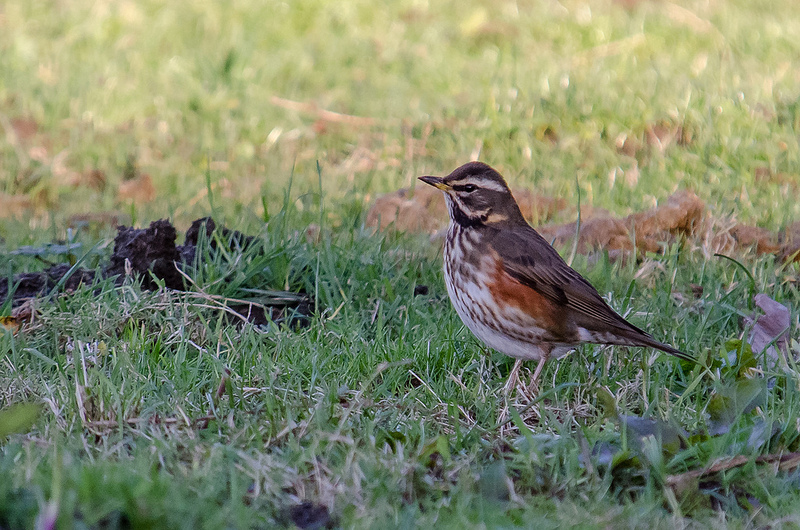 I went out over the Christmas period to count thrushes for the BTO.
I went out over the Christmas period to count thrushes for the BTO.
The winter thrush survey hasn’t really caught my imagination, and I don’t hold great hopes for it producing fascinating results, but the BTO asked me to do it and so I did it gladly.
It wasn’t onerous – a bit of countryside just down the road from where I live, and about an hour of looking for thrushes.
It got me out of the house, I saw a Red Kite, some Red-legged Partridges and a couple of Brown Hares, and I felt more entitled to another mince pie when I returned home.
Last year, in the same square, I saw 11 Blackbirds – this year only six. But to compensate, this year produced a single Song Thrush, 44 Fieldfares and 12 Redwings. I enjoyed watching the Redwings and Fieldfares feeding in a winter wheat field across the road from where I once saw a Short-eared Owl.
I don’t see, or hear, Mistle Thrushes very often around where I live. Do you?
One of the reasons I am quick to volunteer for such surveys is that they give me a local way of being part of a national enterprise. I am pleased to provide my small east Northamptonshire part of a wider national picture. I like the feeling of being part of a bigger enterprise where my small contribution, rather dull and uninteresting in itself, contributes to what might be a fascinating and valuable emerging picture. My observations of the varying number of winter thrushes between last year and this are not very interesting in themselves, even to me, but with thousands of others they might add up to something.
By participating locally in national surveys I also do get a little bit of my local area ‘coloured in’ more sharply in my head. I will now think of one particular field, past which I have driven scores of times, as ‘that field where I saw some Red-legs on the BTO winter thrush survey’. It now has a slightly elevated place in my memory. And at the bottom of two hills, where a stream crosses beneath the road in a culvert, it is now not only ‘the bottom of the hill’, nor ‘the bottom of the hill where you turn off to Duncan’s farm’, nor even ‘the bottom of the hill where you turn off to Duncan’s farm where a Short-eared Owl once perched on the signpost and gave me an excellent view of it’ but it is now ‘the bottom of the hill where you turn off to Duncan’s farm where a Short-eared Owl once perched on the signpost and gave me an excellent view of it and where those Fieldfares and Redwings were feeding when I did the BTO winter thrush survey’.
It is the feeling of contributing to a worthwhile bigger enterprise that gets me out into the field to count birds for the BTO – over many years they have won my trust so that I’ll go out to count thrushes because they asked me even though I have doubts as to how worthwhile it might be. And that trust comes from the track-record of the organisation and the fact that I know lots of other BTO members and staff and I feel, in a small way, as ‘one of the gang’. But I also know, that I will see something that will stick in the mind each time I go out into the field to count birds. There is always some thing, some little thing, that colours in a part of the brain with a memory that will endure.
[registration_form]
Interesting observations Mark. I was speaking with a fellow birder on my local patch just yesterday and mentioned that winter thrush numbers had fallen after a high earlier in the month. It is notable that there are few berries around now but my friend reckoned that thrushes were probably out in the fields foraging due to the milder weather too. Mistle thrushes can be numerous here in the winter but the flocks are mobile and sometimes occur on housing estates. Song thrushes are also variable and I tend to see few if any during the breeding season. Both fieldfares and redwings tend to move on after exploiting the hawthorn berries but it is clear there are a lot of continental blackbirds (non-territorial) around, which a pair of sparrowhawks was targeting after they arrived in October with some success although less so now the blackbirds have learned a few lessons.
Just to say that we have plenty of Mistle Thrushes in our area (East Lincs), one pair regularly nest in a small conifer next to our lounge window. I’m sad to say though that we never see any Song Thrushes.
All thrushes except blackbirds thin on the ground here this season Mark. Berries long gone but lack of frost means worms very much available.
Feels great to be a small part in a very large cog. The whole is more than the sum of its parts.
I have and do take part in many BTO surveys yet this is the one that I have passed on, and this applies to a number of my birding friends too. I found the information and methodology to be a mite confusing and bitty, which didn’t make me want to participate. BTO does loads of great work and I am a strong supporter but just sometime these surveys need an outsiders eye before launch.
Thrush numbers around here (West Yorks) have been unusual this year as we had an early “first wave” which has not been followed by any other, as confirmed by ringing reports from the East coast. The common suspicion is that the weather in continental Europe has been sufficiently mild to allow many birds to stay put. (Note local records of sawbills, bittern etc also).